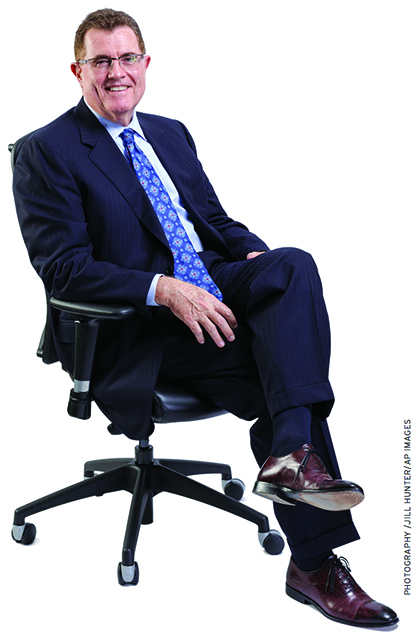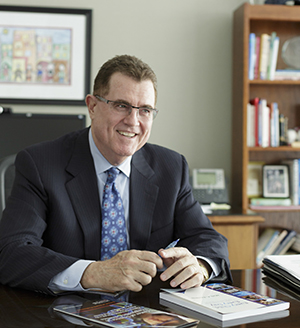The first thing you need to know about Terry Grier is that Houston’s superintendent is intense. The second is the North Carolina native talks fast while making point after point. And the third? This veteran educator is determined.
 Grier remains a reformer five years into his leadership of the Houston Independent School District (HISD), Texas’s largest district. Before taking this post, he had been a principal or superintendent for most of three decades.
Grier remains a reformer five years into his leadership of the Houston Independent School District (HISD), Texas’s largest district. Before taking this post, he had been a principal or superintendent for most of three decades.
Bruises come with being an education leader. The 64-year-old Grier has had his share of them; some were self-inflicted. He acknowledges his ego got ahead of him on some assignments.
After he landed his first superintendent post near Asheville, North Carolina, at age 34, Grier moved on to Amarillo, Texas, where he crashed. He ran afoul of the school board and ended up running a South Carolina district. After four years, he went to Akron, Ohio, and then to Sacramento, where he and the trustees differed. The business community backed him, he says, but the experience was humbling.
From there, he went to a district near Nashville. (He had earned a doctorate from Vanderbilt University.) Then, he became superintendent in Greensboro, North Carolina. After that, it was back to California, where he led San Diego’s district for 18 months. The district’s scores on the California achievement test hit record highs during his brief stint. But he wrangled with the unions over issues like rightsizing the teaching staff for a smaller enrollment. “They went bonzos and have never forgiven me,” Grier says.
He recalls the scene when a union leader publicly berated staff members and several trustees: “My wife was beside herself by the time I got home,” says Grier. “She had watched the meeting and gotten on the website of the Houston district, which had expressed interest in me through a headhunter. She convinced me to talk to them, so I followed up the next morning. I was on the plane that afternoon.”
Notably, five years later, the U-T San Diego newspaper lamented his departure, wondering what might have been if he had not left.
Grier has maintained his passion for improving schools throughout. “I’ve learned through hard knocks,” Grier tells me as he downs a plate of fish tacos over lunch. “I’ve learned through my career that perseverance is a big part of leadership.”
Grier’s focus in Houston, San Diego, and other districts has been on such goals as improving classroom instruction, aiming initiatives at likely dropouts, and getting more minority students to take Advanced Placement (AP) exams.
Houston still struggles with issues like reading strategies. The district also has lost students in recent years, in part because affluent Houstonians are moving into previously low-income neighborhoods. They either don’t have children or are not putting them in public school.
Still, Grier’s priorities have yielded payoffs, including the 2013 Broad Prize for Urban Education. The annual average increase in the rate at which Houston’s Hispanic students took Advanced Placement exams was five times greater between 2009 and 2012 than that of their peers in the 75 other urban districts vying for the Broad Prize. This achievement is particularly significant in Texas, where more than half of public school students are Hispanic.
Dropout rates also have improved during Grier’s tenure. They remain too high, he cautions, but they have declined from 22 percent to 11 percent. And HISD scored higher in the category of postsecondary readiness on the state’s 2013 report card than urban districts in Dallas, Austin, and Fort Worth.
The dark-haired baby boomer shows few signs of letting up. He will take a sidestep or two in achieving his goals, but he won’t relent on modernizing education.
Principal Development

Grier’s survival as a school reformer was the central issue on my mind as we sat down for lunch. The natural storyteller barely paused during our 90-minute conversation.
“One thing I learned long ago is that friends come and go and enemies accumulate,” Grier explains. “But success matters. You have to stay focused on what makes a difference.”
To Grier, that means focusing on kids. Of course, people on every side of every education issue claim it is about the kids. So what does that mean for this educator?
Grier starts with human capital. He had been pressing for higher-quality educators long before Houston called:
“When I was in Akron in the early 1990s, many new teachers came to the urban district from rural Ohio. They may not have even sat down with a student of color. And some didn’t grasp technology, which was coming on at the time. So I invited the leaders of colleges that supplied us with their students to lunch. We were making nice, and I was on my best behavior. I got up and said, ‘We need help. The teachers you are sending us don’t know how to manage their classrooms, inspire their students, or differentiate instruction. I need you to help us redesign the engine for our car. I am asking you to adjust our motor.’ Well, their faces turned red, they got mad, and they started lecturing me.
“But, then, the head of the University of Akron spoke up and said, ‘Terry, you are right. You are one of our biggest customers. We will modify our training program.’
“I thanked him and then told the others that we will not hire another student from their universities until they change their preparation. ‘I will not buy a car that is not meeting my needs,’ I said. ‘Others can hire you.’”
In Houston, Grier has spent much of his political capital on developing principals and teachers. This includes recruiting leaders from other districts, states, and charter schools. The day before we spoke, Grier met with two principal applicants from New Mexico.
Principal wannabes attend a leadership academy, where they receive instruction from experts in both the business and education worlds. “We partner with the master’s in business administration programs at Rice University and St. Thomas University,” Grier explains.
Current principals are “strongly encouraged” to take a marketing course at Rice. Most principals have stepped forward.
The regimen for Navy SEALs inspires him. “They constantly train,” Grier said, his soft southern accent echoing the tones of Billy Graham’s voice.
HISD has replaced half of its 282 principals over the last four years. “A district can’t fire its way to success,” he cautions, pointing out that some were about to retire anyway. Still, he acknowledges that others could not or would not do the work.
Teacher Quality
Boot camp comes twice yearly for Houston’s principals, which is how often they must review each of their teachers with a team from HISD’s central office with members who are trained by The New Teacher Project (TNTP). Principals place every instructor’s name in one of four buckets that range from low performers to irreplaceable instructors. The principal must defend his or her decision about each educator. Meanwhile, the review team uses data to assess the principal’s conclusion, including the teacher’s attendance rates and data from Texas’s annual achievement test, AP exams, and norm-referenced tests.
There was not much of a distinction between high- and low-performing teachers before the new system was launched in 2010. Most were rated acceptable. Among the low performers, only 3 percent were on professional growth plans.
The lack of distinction, Grier says, meant some top teachers didn’t know they were irreplaceable. That can be demoralizing if you are working hard to engage your students. Now, teachers know if they are considered high performers. HISD has retained 98 percent of the educators it deemed high-performing over the last three years and replaced 54 percent of its lowest performers.
For the most part, results have been in Houston’s favor. Teachers whose students show the greatest annual growth are being retained at a greater rate than HISD teachers overall. More students now have teachers who can help them become proficient learners, especially in core subjects like reading and math.
To an outsider, Grier may have been borrowing trouble by introducing the new evaluation system. There was plenty of pushback from opponents, and opposition remains. In fact, seven teachers, backed by the Houston branch of the American Federation of Teachers, have sued over using test data in evaluations. Yet the framework has helped the district drill down into where Houston teachers and schools most need help. The district uses the information to provide personalized teacher development and to create partnerships between teachers. An educator who is strong in, say, math can take math students, while one who is strong in reading can take reading students. “We try to play upon their strengths,” Grier explains.
Houston requires prospective teachers to present a lesson before getting a job. Grier concedes the strategy is not foolproof, but observation helps. “It lets us know whether they can teach,” he says matter-of-factly.
Apollo 20
Grier has a self-assured style that has led some opponents to call him patronizing, arrogant, and, politically, a bull in a china shop. His intensity certainly came through during our conversation. His humor, yarns, and southern manners take part of the edge off, which has helped him win over parts of Houston outside of the board. But he is no hale-and-hearty backslapper.
Critics also point to shortcomings in his Apollo 20 program. Houston, of course, is where the Apollo space program was launched, so Grier and HISD played upon that name when spinning off 20 low-performing schools in 2010 into their own subdistrict of sorts.
The campuses were a mixture of elementary, middle, and high schools. HISD partnered with Harvard University’s Education Innovation Laboratory to identify successful strategies, such as getting effective principals and educators into each school, providing more instructional time, and using data to drive instruction. The district also provided campuses with about $2,500 more per student. (Most of the money came from private sources.)
In rapid-fire fashion, Grier ticks off Apollo 20’s achievements: “It eliminated the math achievement gap in the 11 lowest-performing elementary schools in two years,” he says with emphasis. “We cut in half the math achievement gap in three years in the nine lowest-performing secondary schools.”
The program has expanded to 19 more campuses, and other Houston schools employ concepts learned through Apollo 20. For example, HISD learned to use federal money to match tutors with no more than two or three students.
Results are mixed, though. A Rice University report revealed that reading scores have not improved as much as math results. Even Grier proposed closing one school because of low enrollment. (The board decided only to revamp it.)
A Journeyman’s Tale

Still, Grier’s district did win the Broad Prize. The judges praised Houston for having the highest SAT participation rate among the urban districts competing for the award. Houston’s graduation rate also improved twice as fast as that of other urban districts. And Houston was lauded for narrowing the achievement gaps between white and minority students and between students from low-income families and their higher-income peers.
What’s more, Grier led Houston voters in passing a nearly $2 billion bond package in 2012 to build 32 new schools, modernize 6 others, and provide new technologies. The support was a vote of confidence. In a wonky way, so was the respectable rating HISD received from the state comptroller in her latest review of how much academic growth schools produce for the investments made in them. Some smaller and suburban districts scored higher on the 2013 Financial Allocation Study for Texas, but Houston outpaced Dallas, the next-largest district, as well as urban districts in Fort Worth and San Antonio.
Grier is one of the few district leaders to win superintendent of the year in two different states. He has won that award in Texas and in his native state, North Carolina.
His North Carolina roots run deep, too. When I challenged his opening line about focusing on what’s best for kids, he quoted his rural North Carolina grandfather. “Watch what a man does, not what he says,” Grier recalls him saying.
Grier grew up in Fairmont, a rural town that was so small, he laughs, “Our high school football team didn’t have enough players to scrimmage.”
His father only attended school through 5th grade, so Grier’s first exposure to college was at an East Carolina University summer football camp. He later graduated from the school, where he went to become a pilot. Eye problems intervened, so he headed into education because he liked working with kids.
His maiden teaching job was as a jack-of-all-trades at a high school near the North Carolina-Virginia border. “I taught whatever courses were left over,” he chuckles. His favorite course was one in which he taught students to start their own businesses.
Someone must have seen in him an entrepreneurial bent, a trait an education leader needs. A South Carolina principal soon asked him to join his school and later helped him land a principal’s job back in North Carolina.
That post led to another principal’s position in St. Pauls, North Carolina, where he stayed three years and earned a master’s degree at East Carolina University. A professor there helped him find an assistant superintendent’s job near Hickory, North Carolina. “It was the best learning,” Grier remembers. “I had to do it all.”
Grier’s career has been that of a journeyman. Yet he has persevered, ending up achieving in the largest district in America’s second-most-populous state.
What’s more, he remains on fast-forward. “I’m willing to take longer than expected,” he says at the end of our conversation. “But kids have only so long in school. How long do you want to wait if a student is getting a poor education?”
William McKenzie is editorial director at the George W. Bush Institute in Dallas.
This article appeared in the Fall 2014 issue of Education Next. Suggested citation format:
McKenzie, W. (2014). Still Reforming after All These Years: A conversation with Terry Grier. Education Next, 14(4), 50-53.


